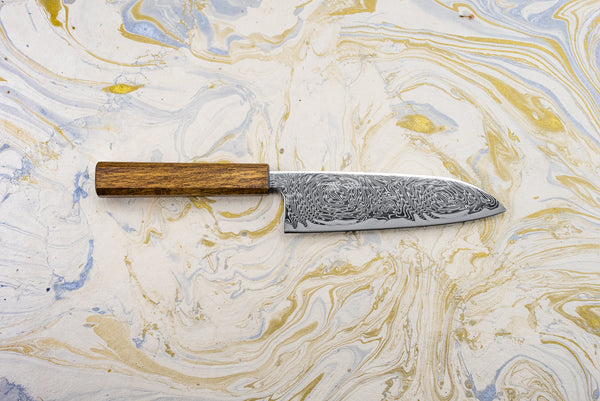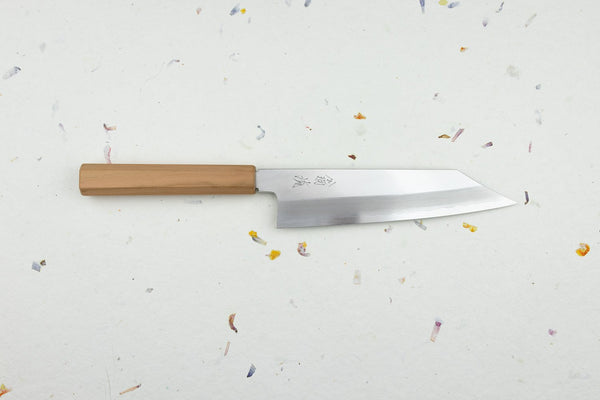
Every Japanese Kitchen Knife Shape Explained
If you're new to Japanese knives, navigating all the terminology can be like learning a new language. Precisely like that, in fact, since you're literally learning Japanese. Luckily, most Japanese terms are easy to learn and pronounce, and most even have English counterparts! Here's a list of the knife shapes you'll come to learn, which ones you need, and roughly in what order you might get them.
The Must Haves

Fujimoto Hammer Tone 210mm Gyuto
Gyuto
Also known as a chefs knife, Gyuto translated to 'cow-sword' and is inspired by classic French chef's knives. The go-to knife in most kitchens around the globe, a gyuto can do almost anything, but it does have a bias towards larger food and meats. They range in length between 150mm all the way up to an impressive 360mm, with 210mm and 240mm being the most common lengths. If you’re minimally minded and only want one knife, get a gyuto! Learn more about Gyutos.

Petty
This is the Japanese word (via French) for a paring or utility knife. It’s perfect for hand peeling fruits and veggies, but is equally as handy on a cutting board for tasks that require greater articulation - trimming fat and silver skin off meats, or de-coring a mango come to mind. Pettys can be as small as 75mm, and as large as 180mm, so there’s something to fit any hand, big or small.

Nakiri
The naikiri isn’t the most well known shape in the Western kitchen, but they are hands-down the best tool for the job they’re made for. With their flat edge they make chopping vegetables a breeze. The push chopping technique which the nakiri makes incredibly easy to do reduces those annoying accordion cuts. You know, when your onions are strung together like a string of paper dolls? Do yourself a favour and Google a solid French onion soup recipe and go to town with your nakiri. Learn more about nakiris.

Santoku
Santoku means “three virtues,” or “to solve three problems.” With this aptly named knife, these jobs will be that much easier. Slicing, dicing and mincing. If you can master these cuts, you can pretty much attack any recipe launched at you. The santoku starts flat at the heel, exceptional for cutting vegetables, and eventually curves upwards towards the tip, giving it more versatility for slightly finer work. Many folks prefer a santoku over a gyuto, so it will often the first knife for home cooks. Learn more about santokus.
Bunka
The bunka is a more badass santoku, with a dramatic sloped tip. It carries the same functionality of its cousin. While the bunka was actually invented first, the santoku has since become the more popular choice. Maybe the general public just can’t handle how rad they are.

Sujihiki
Christmas, Thanksgiving, or just a casual Sunday dinner, this long, thin 'flesh slicer', as it's called in Japanese, is exactly the tool you want to carve those fine cuts of roast beef, turkey, fish and raw meats. If it’s meaty, a sujihiki will slice through it with buttery elegance. Learn more about Sujihikis.
Bread Knife
It speaks for itself! With a serrated edge, bread knives offer exceptional toothiness for cutting through both the softest and crustiest loafs. Look for one made of super hard steel - they’ll keep their aggressive little teeth the longest!
The Fun-to-Haves
Honesuki
Specifically designed for poultry butchering, the honesuki’s flat profile and dropped tip makes it perfect for navigating around the meat and bones of chicken and other birds. The tip is thin and precise, while the heel is robust for cutting through cartilage. Learn more about honesukis.
Ko-Bunka
The Ko Bunka is a smaller version of a Bunka. Any guesses on what “Ko” means in Japanese? You nailed it! It translates to “small.” This little knife is awesome because it still gives you knuckle clearance on the cutting board, making sure you can mince garlic and comfortably chop veggies. A badass love child of the Bunka and Petty knife, it works for smaller jobs in the hand or as an all-purpose blade.

Oul Sakai Ginsan 210mm Kiritsuke
Kiritsuke
A chef’s knife with a sloped tip similar to the bunka, a kiritsuke can come in single or double beveled varieties. The double bevel ones are a great substitute for a gyuto if you prefer a flatter edge. 'Kiritsuke' also refers to the tip style, so you can get kiritsuke sujihikis, santokus, gyutos, petties, and more!
Kamagata
Originally designed to cut rubber soles for shoemaking, this rare shape compliments any knife collection perfectly. Shallots, garlic, herbs, itty bitty diced onion and tomato, beef tartare… none can stand up to the small but mighty Kamagata. This uniquely shaped vegetable knife has a flat edge like a Nakiri, making it perfect for chopping herbs or slicing small vegetables like shallots or garlic. Its compact size also makes it great for line cooks.
Yanagiba
Yanagibas are long, thin, single-bevel knives ground and sharpened on one side. They excel at delicate preparations like sashimi and skinning fish fillets, but can be an excellent alternative to a sujihiki.

Sakai Takayuki Uzushio 180mm Deba
Deba
The deba is an essential knife in a sushi chef’s kitchen, perfect for filleting and butchering fish. We’ve also seen them used to butcher poultry, much like a honesuki. The edge is razor sharp, but the thick spine allows for robust cutting of fish bones.
Sakai Takayuki Suigyu Kasumotogi 165mm Usuba
Usuba
Aptly translated to “thin blade,” an usuba (oo-soo-ba) is a single-bevel knife ground and sharpened on one side, making it perfect for slicing vegetables super thin. Another must in the sushi-chef’s arsenal.

Silverthorn Flexible Boning Knife
Boning Knife
While the mighty honesuki makes quick work of birds and smaller fish, a flexible boning knife is a must-have for anyone wanting to butcher larger animals or work around bones on a regular basis. These blades tend to have a little flex for working around curves while the narrow blade is perfect for trimming silverskin and getting into tight spaces.
Meat Cleaver
Despite its name, the classic butcher's cleaver is primarily cutting bones, not meat. These hefty, thick blades are made from softer steel that still keeps a great edge but can take a hit. If you like to do your own butchery and make stock, grab one of these for your kit!
Chinese Cleaver/ Chuka Bocho
The Chinese cleaver is a unique and versatile shape of the knife. For many classically trained Chinese chefs, these hefty blades are their chef's knife, performing nearly every kitchen task imaginable. A 'Chuka-Bocho' is a Chinese cleaver made in Japan from Japanese steel. Both come in a variety of blade thicknesses, ranging from razor-thin for slicing garlic, to wedge-thick for splitting bones. Many chefs will sharpen different parts of their cleaver for different purposes, allowing them to do everything with one large blade.




 Masashi Kokuen K-Bunka
Masashi Kokuen K-Bunka








